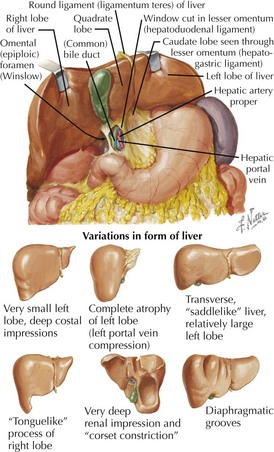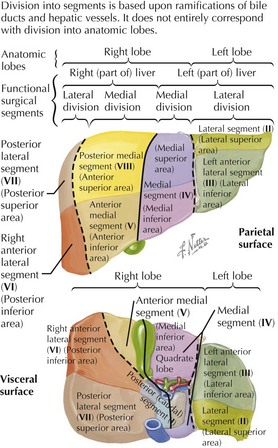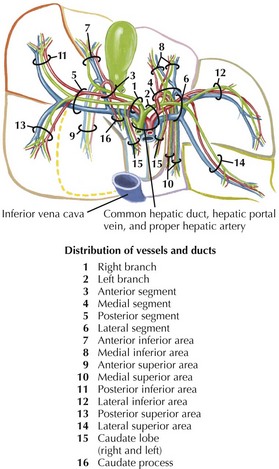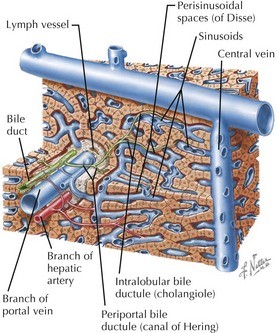13 Liver Diseases
Anatomy of the Liver
Basic Gross Anatomy
• Hepatoduodenal ligament: peritoneal fold surrounding portal triad (hepatic artery proper, portal vein, bile duct), right edge of lesser omentum
• Omental foramen (of Winslow): posterior to hepatoduodenal ligament, opens into lesser (peritoneal) sac
Divisions
• Right and left hepatic lobes: divided by a plane extending from cystic fossa (anteroinferior) through inferior vena cava (superoposterior)
• Each hemiliver contains its own hepatic artery branch, portal blood supply, venous drainage, and bile duct.
• Further division into 8 segments, resectable based on blood vessel and bile duct anatomy
 Segment III: left lateral division, left portal lobe, left lateral anterior segment (lateral inferior area)
Segment III: left lateral division, left portal lobe, left lateral anterior segment (lateral inferior area)
 Segment V: right medial division, right portal lobe, left anterior medial segment (anterior inferior area)
Segment V: right medial division, right portal lobe, left anterior medial segment (anterior inferior area)
 Segment VII: right lateral division, right portal lobe, posterior lateral segment (posterior superior)
Segment VII: right lateral division, right portal lobe, posterior lateral segment (posterior superior)
 Segment III: left lateral division, left portal lobe, left lateral anterior segment (lateral inferior area)
Segment III: left lateral division, left portal lobe, left lateral anterior segment (lateral inferior area) Segment V: right medial division, right portal lobe, left anterior medial segment (anterior inferior area)
Segment V: right medial division, right portal lobe, left anterior medial segment (anterior inferior area) Segment VII: right lateral division, right portal lobe, posterior lateral segment (posterior superior)
Segment VII: right lateral division, right portal lobe, posterior lateral segment (posterior superior)Portal Triads and Bile Duct System
• Portal triads—hepatic artery, bile duct, and portal vein branches—and lymphatics seen in characteristic relationships from microscopic (lobular) to macroscopic (lobar) levels
• Popular functional concepts of liver parenchyma include classic lobules and liver acini organized around vessels.
• Interlobular hepatic artery branches travel alongside portal veins in septa, providing smaller branches to ducts and parenchyma (hepatocytes) of lobules.






















